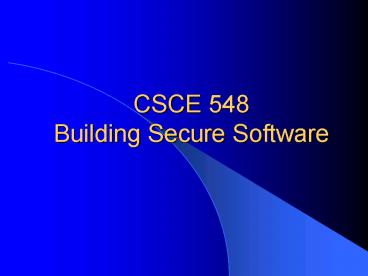CSCE 548 Building Secure Software PowerPoint PPT Presentation
1 / 20
Title: CSCE 548 Building Secure Software
1
CSCE 548 Building Secure Software
2
Class Info
- Instructor Csilla Farkas
- Office Swearingen 3A43
- Office Hours Tuesday, Thursday 200-330 pm or
electronically any time or by appointment - Telephone 576-5762
- E-mail farkas_at_cse.sc.edu
- Class homepage http//www.cse.sc.edu/farkas/csce
548-2008/csce548.htm
3
Text Books
- Software Security Building Security In by Gary
McGraw, Publisher Addison-Wesley Professional,
February 2, 2006, ISBN-10 0321356705 ISBN-13
978-0321356703 - 19 Deadly Sins of Software Security by Michael
Howard, David LeBlanc, John Viega, Publisher
McGraw-Hill Osborne Media, July 26, 2005,
ISBN-10 0072260858, ISBN-13 978-0072260854
4
Assignments
- Research project one research project related to
software security. - Homework There will be 4-5 homework assignments
during the semester. - Exams two closed book tests (given approximately
at 1/3 and 2/3 of the semester) will cover the
course material. No final exam.
5
Grading
- Test 1 25, Test 2 25, Homework 15, Research
project 35 - Total score that can be achieved 100
- Final grade 90 lt A 87ltBlt 90 80ltBlt87
76ltClt80 66ltClt76 61ltDlt66 45ltDlt61
6
Reading
- This lecture
- McGraw Chapter 1
- Recommended
- CyberInsecurity The Cost of Monopoly,
http//cryptome.org/cyberinsecurity.htm - Next lecture
- McGraw Chapter 2
7
Why do we need software security?
- Software is essential in most every aspect of our
life
8
How to address software security?
- Do not address at all
- Ad-hoc evaluation
- Add security features after the fact
- Identify security vulnerabilities
- Test security level
- Incorporate security throughout of SDLC
9
This Course
- Not a software engineering course
- Understand basic security concepts and their
impact - Introduce systematic security design and
development along project management - Best practices
10
Security Objectives
- Confidentiality prevent/detect/deter improper
disclosure of information - Integrity prevent/detect/deter improper
modification of information - Availability prevent/detect/deter improper
denial of access to services
11
Software Security
- NOT security software!
- Engineering software so that it continues to
function correctly under malicious attack - Functional requirements
- Non-functional requirements (e.g., security)
12
Why Software?
- Increased complexity of software product
- Increased connectivity
- Increased extensibility
- Increased risk of security violations!
13
Security Problems
- Defects implementation and design
vulnerabilities - Bug implementation-level vulnerabilities
(Low-level or mid-level) - Static analysis tool
- Flaw subtle, not so easy to detect problems
- Manual analysis
- Automated tools (for some but not design level)
- Risk probability x impact
14
Application vs. Software Security
- Usually refers to security after the software is
built - Adding more code does not make a faulty software
correct - Sandboxing
- Network-centric approach
- Application security testing badness-ometer
Who Knows
Deep Trouble
15
Three Pillars of Software Security
- Risk Management
- Software Security Touchpoints
- Knowledge
16
Risk Management
- How much effort to invest in security
- Consequences of security breaches
- Acceptable-level of security
- Tracking and mitigating risk throughout the full
SDLC
17
Touchpoints
- System-wide activity from design to testing and
feedback - Focus on security from ground up
- Touchpoints
- Code review
- Architectural risk analysis
- Penetration testing
- Risk-based security testing
- Abuse cases
- Security requiremetns
- Security operations
18
Knowledge
- Gathering, encapsulating, and sharing security
knowledge - Knowledge catalogs principles, guidelines,
rules, vulnerabilities, exploits, attack
patterns, historical risks - Knowledge categories
- Prescriptive knowledge
- Diagnostic knowledge
- Historical knowledge
- Applied along the SDLC
19
Security Engineering
- Reduce the need for reactive technologies (e.g.,
intrusion detection) by safer products ?
Understand software - Need for
- Software developers
- Operations people
- Administrators
- Users
- Executives
20
Next Class
- Risk Management

